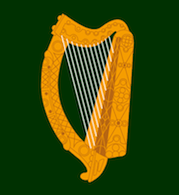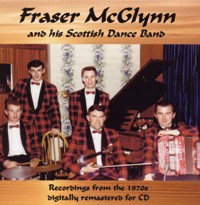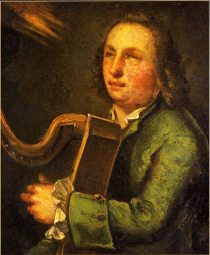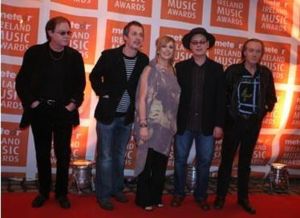Irish Music
In ancient times the bards were employed at court to sing or recite verse recalling deeds of bravery and generally praise the ruling monarch. Occasionally the bards would travel around other kingships and they were highly respected and well received. Every king or chieftain employed professional people like bards and fili, not just to entertain but also to perform a number of official roles including keeping records of various events in verse and teaching pupils these skills. The Celts had a primitive alphabet known as ogam and at best it could be used to record a person’s name. Knowledge was important in ancient times, as it is today, and without a proper form of writing the only method of storing information was in song or verse. With the introduction of Christianity in the fourth century came the more modern art of writing but the teaching methods of the bards was also important. Using the art of writing in conjunction with the teaching methods of the bards, these Bardic Schools were in existence up to the mid seventeenth century. It is written that during the fifth and sixth centuries, the bards went forth to instruct the Gothic nations, and astonish the court of Charlemagne. It is also written that poets from around the world attended bardic contests in the hall of harps at Tara in the days of Brian Borhoime. The bards were masters of rhyme and occasionally their eagerness to please their employer could lead to some exaggeration of an event. Carolan is often referred to as the last of the great Irish Bards. Born in Co. Meath in 1670 Carolan was a blind early Irish harper, composer and singer of the highest quality. He was fond of a strong drink and on this subject he wrote:
‘He’s a fool who give over the liquor,
It softens the skinflint at once,
It urges the slowcoach on quicker,
Gives spirit and brains to the dunce…’
We don’t have to go back to ancient times to witness the commemoration of people or events in song, and today there might also be a slight exaggeration of the facts to help make a verse rhyme or please the audience. An example of this can be found in the song ‘Johnston’s Motor Car’ which was written by Willie Gillespie to commemorate the hijacking of a local doctor’s car in 1921 by the IRA to transport arms from Cloghan to Dungloe. Part of the song states ‘You could hear the din going through Glenfin…’ and Dr. Johnston disagreed with this line claiming that there was no din from his motor car as it was regularly serviced and kept in good running order. ‘The Hills of Glenswilly’ was written by Mick Mc Ginley to commemorate the mass emigration from Ireland after the famine. Songs like ‘The Forty Shades of Green’, I’ll Take You Home Again Kathleen’ and Paddy’s Green Shamrock Shore’ were popular at home and well received among the Irish immigrants in countries like America and Canada. In later times the dance halls were the gathering places for young folk and the show bands played a wide variety of tunes which included ballads and love songs like ‘The Black Velvet Band’,’ Danny Boy’, ‘The Rose of Tralee’ and’ When You Were Sweet Sixteen’.
For many centuries instruments like the harp and the flute have been popular. There were many great flute players over the years and most of us will remember the story entitled ‘The Pied Piper of Hamelin’. Some historians believe that this tale was based on a true story which happened in a small German village in the year 1284. The town was evacuated because of an outbreak of war and 130 children, who were evacuated separately, were never reunited with their families. Well known flutists around Ireland are Troy Bannon from Dublin, Billy Clifford from Kerry, Garry Hastings from Belfast and Stephen Mc Elhinney from Donegal.
 The harp is our national emblem and it first appeared on a green background symbolising Ireland during the 1641 rebellion which was led by Eoghan Rua O’ Neill. He was one of Ireland’s best commanders. The harp is represented on early Christian stone crosses and this reflects the importance of music. The fiddle and the accordion have left their mark on traditional Irish music and Thomas Moore, who many would consider to be the national bard of Ireland , wrote some popular tunes like ‘The Last of Summer’ and‘ The Harp That Once Through Tara’s Halls’.
The harp is our national emblem and it first appeared on a green background symbolising Ireland during the 1641 rebellion which was led by Eoghan Rua O’ Neill. He was one of Ireland’s best commanders. The harp is represented on early Christian stone crosses and this reflects the importance of music. The fiddle and the accordion have left their mark on traditional Irish music and Thomas Moore, who many would consider to be the national bard of Ireland , wrote some popular tunes like ‘The Last of Summer’ and‘ The Harp That Once Through Tara’s Halls’.
‘The harp that once through Tara’s halls
The soul of music shed,
Now hangs as mute on Tara’s walls,
As if soul were fled’.
The most famous bard in Scotland was Robert Burns and Shakespeare was popular in England. Blind Raftery of Connacht was known as the last of the wandering bards and Oscar Wilde who is best known for his plays wrote ‘The Ballad of Reading Gaol’. Douglas Hyde, the first President of Ireland’ wrote ‘Love Songs of Connacht’ and this book was widely admired. Frances Browne, the poetess from Stranorlar wrote an informed piece for Hogg’s Instructor entitled ‘The Music of Ireland’
Music is part of everyday life and it is used for a variety of purposes. Years ago, before battle, the opposing warriors would bang on drums and chant insults at each other. In Viking times the church bell was rung to warn people of attacks and today clocks chime to remind us of the time. Big Ben is a famous clock and it rings every hour. In other places like Africa and America the drums were used at celebrations and also to relay messages across the land. We use music in church, at wedding celebrations, dances and we often sing to babies. There are different types of music like gospel, country and western, pop, rock ‘n’ roll, disco and opera. We have our favourite singers and competitions like ‘The Voice of Ireland’ and the ‘Eurovision Song Contest’ are hugely popular. Music is usually played before and after a film. ‘Seven Brides for Seven Brothers’ and ‘The Fiddler on the Roof’ were popular musicals. ‘The Jungle Book’ is a well-known cartoon film with music. Almost every town has a choir and we enjoy carol singing at Christmas.Major Irish folk bands include Dervish, Altan, Stockton’s Wing, Four Men and a Dog, and De Dannan. The Gweedore group Clannad are very popular and Enya is an international star. Irish folk singers like Mary Black and Sharon Shannon often appeared on British television but it was the pub sessions that became the home of traditional music and many local musicians have contributed to this success. When Colm Duffy, who resides in Stranorlar, managed the popular Irish club in London ‘Aras na nGael’, he brought many top Irish artists to perform there in the nineties.
The brothers, John and Michael Doherty often played around the Twin Towns. Simon was a tinsmith and carried his fiddle with him when selling his products around the countryside. The fiddling tradition is very much alive today with musicians like Paddy Mc Menamin from Cloghan in popular demand. Miss Gallinagh from Ballybofey recently attended a fiddling school in Romania.
Jimmy Houston from Drumkeen was regarded as one of the finest exponents of the art of fiddle playing from Donegal. He played with other well-known fiddlers like John Mc Glinchey of Gortamuck, Sean Donnelly of Donnyloop, the Molloy’s of Clady, the Mc Philemy’s of Castlefin and Johnny Dumphy of Spamount near Strabane. Before Jimmy went to England in 1949, he played in ‘The Ceili Band’ with Sean Bradley who was a well-known dancer and fiddle player. On his return from England, Jimmy played with ‘The Tirconaill Ceili Band’. The band members were John Murray, drums; Mary Smith, fiddle; Patsy Wilson, accordion; John Lee, flute; Oliver Thompson, fiddle and Frank Kelly, fiddle. The band played at various venues all over Ireland.
Hughie Gillespie’s fiddle playing is described as ‘out of this world’ and this could be because he ’… heard fairies playing fiddles when he was a boy at his uncle’s farm in Brockagh’. Hughie played for many years in America with Michael Coleman. A monument was erected in Killavil, Co. Sligo to commemorate Michael Coleman and in the 1930s he was hailed as the greatest living exponent of Irish traditional fiddling. Hughie and Michael were in a league of their own and Hughie’s daughter was also a very fine fiddle player. The boys played four nights a week at Carnegie Hall and their music was broadcasted live on American radio. Many famous people like Fritz Kreisler and Henry Ford often attended their concerts.
The late Dinny Bonner from Drumboe, Stranorlar was a master accordion player and he toured the country for many years with Paddy Mc Cafferty’s band. In later years he played with his son Denis at weddings and local events. In the fifties and early sixties, Paddy Mc Cafferty’s band was considered to be one of the best in Ireland. It was around this time the band introduced Brendan Boyer’ on stage for the first time in Co. Donegal, at a festival in Glenties.
 On the subject of accordions, how many will know the name of Fraser Mc Glynn? He is a household name in Scotland and his father was born in Letterbrick, Cloghan. Fraser started playing the button key accordion at the age of thirteen. His band was formed in 1965 and they passed the BBC broadcasting audition the following year. The band travelled extensively playing at dances and concerts across the British Isles. Edinburgh Castle on New Year’s Eve was a popular venue. Some of his popular tunes are ‘Gaelic Waltz’, ‘Boston Two Step’, ‘Irish Hornpipes’, ‘Pride of Erin Waltz’ and ‘Archie’s Marches’.
On the subject of accordions, how many will know the name of Fraser Mc Glynn? He is a household name in Scotland and his father was born in Letterbrick, Cloghan. Fraser started playing the button key accordion at the age of thirteen. His band was formed in 1965 and they passed the BBC broadcasting audition the following year. The band travelled extensively playing at dances and concerts across the British Isles. Edinburgh Castle on New Year’s Eve was a popular venue. Some of his popular tunes are ‘Gaelic Waltz’, ‘Boston Two Step’, ‘Irish Hornpipes’, ‘Pride of Erin Waltz’ and ‘Archie’s Marches’.
Much more could be written on the subject of music and a growing number of new songs are being released each year. This indicates that our love of music is as strong today as it was back in Celtic times.



